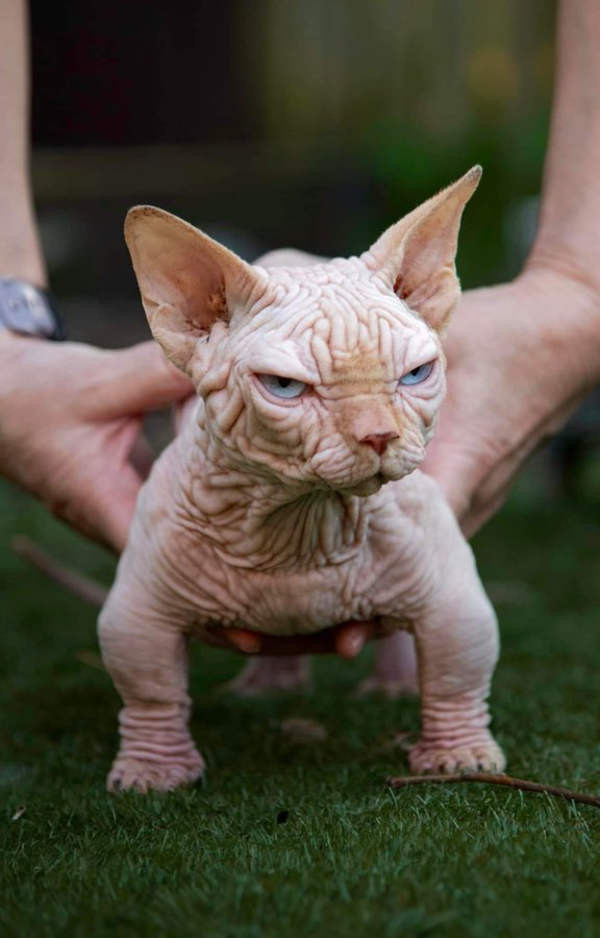Pet owners have been urged to avoid the hybrid breed of cat that resembles XL bully dogs, after it grew in popularity on social media.
Known as “bully cats”, the US bred hybrid cat is a mix of a hairless gene from Sphynx cats with the short-legged gene from Munchkin cats. However, animal experts have warned that the breed has a significantly shorter lifespan of only six years as well as an array of other health complications.
Animal welfare organisations are particularly concerned about the rise of “bully cats”, with the NatureWatch Foundation highlighting the “disturbing” trend on platforms like Instagram and TikTok. A spokesperson said: “It’s shocking to see these poor cats starting to appear in the UK. This kind of breeding is just cruel.”
Dr Grace Carroll, an animal behaviour specialist at Queen’s University Belfast told the Telegraph that pet owners should exercise caution when purchasing experimental breeds as ultimately “consumers hold purchasing power.” She said: “By refusing to buy breeds with extreme traits, we can discourage breeders from prioritising aesthetics over the health and welfare of the animals.”
Dr Carroll added: “Kittens already have a limited ability to regulate their body temperature, which is further complicated by hairlessness, making them susceptible to respiratory infections and skin issues.” She also pointed out that the breed is likely to have a communication handicap due to having no whiskers, like the sphynx cat, as well as poor spatial awareness and navigation ability.
The breed is said to have a communication handicap due to having no whiskers, like the sphynx cat as well as poor spatial awareness and navigation ability.
According to Dr Carroll, the exaggerated features of the breed are believed to be behind respiratory complications whilst the hairlessness leaves them vulnerable to skin cancer and sunburn.
Dr Dan O’Neill, Associate Professor of Companion Animal Epidemiology at the Royal Veterinary College, described the breeding of bully cats as a ‘heartbreaking’ invention, which he said would lead to many pets leading a life ‘blighted with suffering.’
“The advice to anyone thinking of acquiring a cat or a dog is to always put the welfare of the animal first and to stop and think before acquiring an animal with an extreme and unnatural body shape that does not exist commonly in nature.”
An RSPCA spokesperson urged breeders to prioritise the health and welfare of any animal over the way they look earlier this year, saying: “We understand that their emerging presence on social media may fuel a demand for these kinds of cats but we would urge fellow cat lovers to consider adopting the many rescue cats in our care instead of buying from a breeder.”
The ‘Bully Cat’ Controversy: A Case Study in Breeding Ethics
The emergence of the “bully cat” breed is a stark reminder of the ethical considerations surrounding selective breeding in animals. While breeders often cite aesthetics and demand as their motivations, the welfare of these animals is often overlooked. This breed, with its short legs, hairlessness, and lack of whiskers, is a prime example of how prioritizing appearance can lead to a cascade of health issues for animals.
The “bully cat” controversy underscores the need for responsible breeding practices. Breeders should prioritize the health and welfare of their animals, ensuring that they are free from genetic defects and prone to minimal health issues. This means carefully selecting breeding pairs, conducting genetic testing, and providing proper care and nutrition.
Beyond the Hype: Letting Cats Be Cats
As Dr Carroll said, we should “let cats be cats.” This means respecting the natural features and behaviors of cats, and not breeding for traits that compromise their health and well-being. The “bully cat” breed, with its exaggerated features, is a stark departure from the natural feline form. This raises concerns not only for the individual cats but also for the ethical implications of breeding practices that prioritize aesthetics over health.
Animal welfare organizations, such as the RSPCA and NatureWatch Foundation, are playing a vital role in raising awareness about the potential harm of irresponsible breeding practices. Their efforts highlight the need for a shift in the way we think about animal breeding, prioritizing the health and well-being of animals over fleeting trends. It is time to let cats be cats, free from the pressures of artificial selection and the health complications it brings.

















